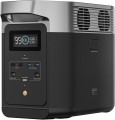Peak power
Some electrical appliances (in particular, units with electric motors - refrigerators, air conditioners, etc.) consume significantly more energy at startup than after reaching the operating mode. For such a load, the peak power of the charging station must be taken into account - its indicator must be higher than the starting power of the load.
USB A (quick charge)
Full size
USB A ports with fast charging support. It allows you to charge your smartphone, tablet or other connected device much faster. The charging process takes place at increased power, and the current and voltage at each stage are regulated in such a way as to remain within the optimal values. However, it should be borne in mind that in our time there are many fast charging technologies and not all of them are compatible with each other.
- The strength of the current. The parameters of the current issued through the USB A fast charging connectors. Note that different voltage and current parameters can be output to different ports of the charging station. This item specifies the current values at a certain voltage (for example, 5 V / 3 A, 9 V / 2 A, 12 V / 1.5 A).
— Power. The maximum power in watts (W) that the charging station is capable of delivering through the USB A fast charging connector to one charging device. High output power allows you to speed up the charging process. However, the appropriate power must be supported by the device being charged - otherwise the speed of the process will be limited by the characteristics of the gadget.
USB C
USB type C ports are smaller than classic USBs, and they also have a convenient reversible design that allows you to connect the plug in either direction.
USB type C was originally designed to be able to implement various advanced features: increased power supply, fast charging technologies, etc.
Since the port is relatively new and quite powerful (there are
USB type C with a power of 60 W and even
100 W), the total number of such connectors is often limited to
1 port, less often
two).
- The strength of the power. The maximum power output through the USB type C connector to a charging device. Note that different ports of the charging station can output different power (for example, 1.5 A and 2.1 A). In this case, the highest power strength is usually indicated.
— Power. The maximum power in watts (W) that the charging station is capable of delivering to one rechargeable gadget. The high output power of the USB type C port allows you to speed up the charging process. However, the appropriate power must be supported by the device being charged - otherwise the speed of the process will be limited by the characteristics of the gadget.
Battery capacity
Nominal
battery capacity, in fact - the amount of energy that is supposed to be stored. The larger it is, the longer the battery life of the charging station will be, all other things being equal. On the other hand, this parameter also affects the dimensions, weight and price of the battery, despite the fact that an energy-intensive battery is not always required. By the indicator of capacity in watt-hours, you can compare batteries with each other.
Charging time (socket) ≈
Time to charge the portable power station from a fully discharged state to 100% charge when using the power adapter from a household outlet. This refers to the original battery and standard charger.
Charging time (solar panel) ≈
Time spent on a full charge when using the original panel in bright sunlight. In cloudy weather, the charging time of the device from the solar panel can be strikingly different downwards.
Charging power (socket)
The power at which, in normal mode, the portable power station is charged from a household outlet when using the original power supply.
Charging power (solar panel)
The power in watts provided when charging a device from a solar panel.
The higher the charging power, all other things being equal, the less time it will take to replenish the energy reserves in the cells of the device's own battery. This section provides the maximum power value that the charging station can accept. Accordingly, this indicator is supposed to be taken into account when choosing compatible solar panels.
Backlight
The presence in the charging station of illumination by the type of flashlight. This feature will come in handy when using the device in low light conditions - at dusk and even in complete darkness.
Illumination is implemented in different ways: in some models it is made in the form of a light diffuser, in others it has a directional beam that illuminates the space at a certain distance. Also, the backlight can have brightness control and different modes of operation (continuous light, flashing, SOS signal).

